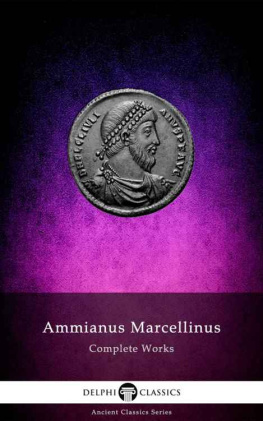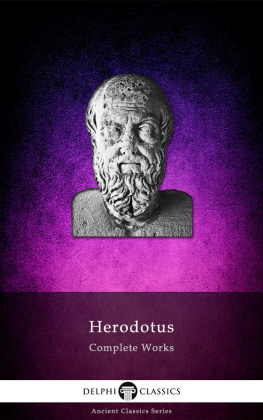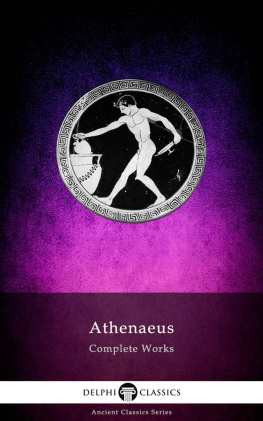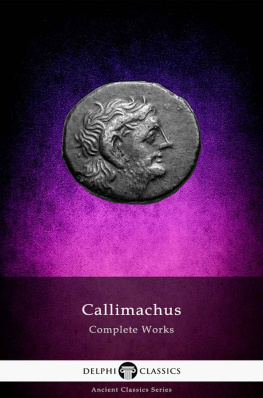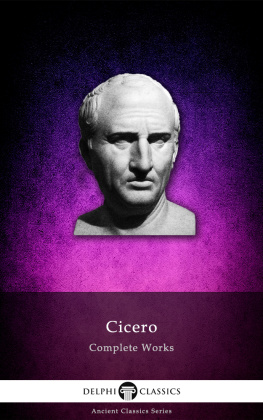The Complete Works of
AMMIANUS MARCELLINUS
(c. AD 325c. 391)

Contents

Delphi Classics 2016
Version 1

The Complete Works of
AMMIANUS MARCELLINUS

By Delphi Classics, 2016
COPYRIGHT
Complete Works of Ammianus Marcellinus
First published in the United Kingdom in 2016 by Delphi Classics.
Delphi Classics, 2016.
All rights reserved. No part of this publication may be reproduced, stored in a retrieval system, or transmitted, in any form or by any means, without the prior permission in writing of the publisher, nor be otherwise circulated in any form other than that in which it is published.
Delphi Classics
is an imprint of
Delphi Publishing Ltd
Hastings, East Sussex
United Kingdom
Contact: sales@delphiclassics.com
www.delphiclassics.com
The Translations

Ruins at Antioch on the Orontes, an ancient city on the eastern side of the Orontes River, near the modern city of Antakya, Turkey Ammianus birthplace

Victorian drawing of Antioch by Byam Martin
HISTORY OF ROME

Ammianus Marcellinus was a fourth-century Roman soldier and historian, whose sole surviving work, Res Gestae , is now regarded as the penultimate major historical account surviving from Antiquity, with the last being by Procopius. Ammianus History of Rome chronicled the years AD 96, from the accession of Nerva, to the death of Valens at the Battle of Adrianople in AD 378, forming a continuation of Tacitus great historical work. Ammianus presumably completed his work before 391, as in the twenty-second book he praises the Serapeum in Egypt as the glory of the empire, though in that year the Emperor granted the temple grounds to the Christian bishop, causing the pagans to barricade themselves in the temple, plundering its contents and torturing Christians, leading to the temples destruction.
Res Gestae was originally written in thirty-one books, but the first thirteen books are now lost, with the extant text of eighteen books covering the years 353 to 378. As a whole the text is considered extremely valuable, offering a clear and comprehensive account of events by a contemporary witness. However, like most ancient historians, Ammianus had a strong political and religious agenda to pursue, as demonstrated by his contrasts of the emperors Constantius II and Julian, always to the formers disadvantage. Edward Gibbon judged Ammianus an accurate and faithful guide, who composed the history of his own times without indulging the prejudices and passions which usually affect the mind of a contemporary. Nevertheless, Gibbon also criticised Ammianus for his lack of literary flair: The coarse and undistinguishing pencil of Ammianus has delineated his bloody figures with tedious and disgusting accuracy.
Ammianus provides us with a remarkably accurate and impartial record of his own times. As an experienced soldier, who joined the army when still young, serving under the governor Ursicinus and the emperors Constantius II and Julian, his work is rich in military experience, demonstrating a keen understanding in economic and social affairs. Ammianus is also refreshingly broad-minded towards non-Romans and accepting of Christianity. His polished style indicates that his prose was intended for recitation, yet the concise and knowledgeable manner of conveying his historical account ensures that we gather a clear understanding of the causes of the Roman empires fall.
The surviving text has suffered badly from the manuscript transmission. As well as the loss of the first thirteen books, the remaining eighteen are in many places corrupt and contain lacunae. The sole surviving manuscript from which almost every other is derived is a ninth-century Carolingian text, named Vatican lat. 1873 (V), produced in Fulda from an insular exemplar. The only independent textual source for Ammianus lies in Fragmenta Marbugensia (M), another ninth-century Frankish codex, which was taken apart to provide covers for account-books during the fifteenth century. Only six leaves of M survive; however, before this manuscript was dismantled the Abbot of Hersfeld lent the manuscript to Sigismund Gelenius, who used it in preparing the text of the second Froben edition (G).

Ancient depiction of Constantius II (317-361) on horseback with a spear. Constantius II was Roman Emperor from 337 to 361. The second son of Constantine I and Fausta, he ascended the throne with his brothers Constantine II and Constans after their fathers death.

Portrait of Julian (Julian the Apostate) on a bronze coin from Antioch, (c. 331-363). Julian was Roman Emperor from 361 to 363, as well as a notable philosopher and author of Greek works.

Edirne, Turkey near the site of the Battle of Adrianople, which took place on 9 August 378 and forms the last major event of Ammianus historical work.

Valens (328-378), who was Emperor from 364 to 378 and led the Eastern Roman army during the Battle of Adrianople.
C. D. YONGE TRANSLATION, 1862

CONTENTS
PREFACE.
Of Ammianus Marcellinus, the writer of the following History, we know very little more than what can be collected from that portion of it which remains to us. From that source we learn that he was a native of Antioch, and a soldier; being one of the prefectores domestici the body-guard of the emperor, into which none but men of noble birth were admitted. He was on the staff of Ursicinus, whom he attended in several of his expeditions; and he bore a share in the campaigns which Julian made against the Persians. After that time he never mentions himself, and we are ignorant when he quitted the service and retired to Rome, in which city he composed his History. We know not when he was born, or when he died, except that from one or two incidental passages in his work it is plain that he lived nearly to the end of the fourth century: and it is even uncertain whether he was a Christian or a Pagan; though the general belief is, that he adhered to the religion of the ancient Romans, without, however, permitting it to lead him even to speak disrespectfully of Christians or Christianity.
Next page


